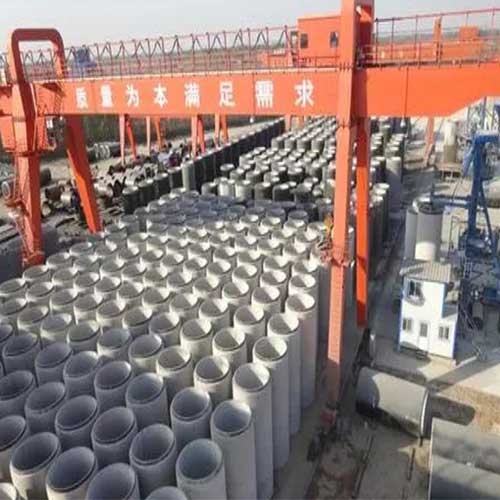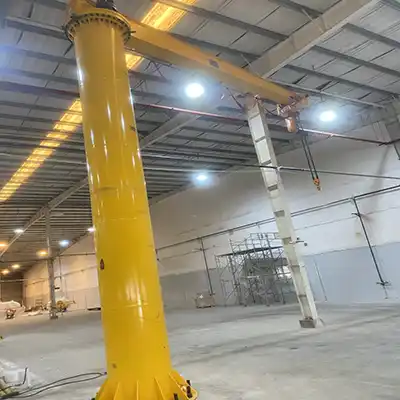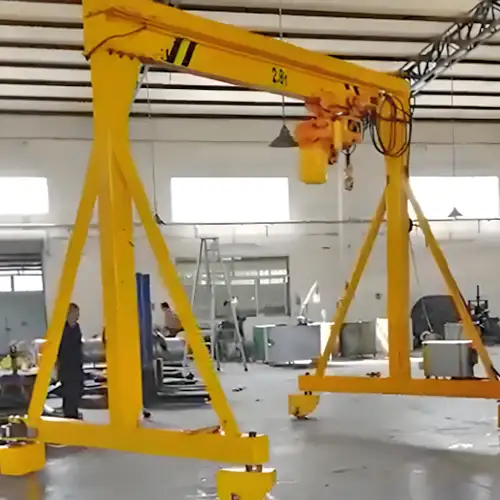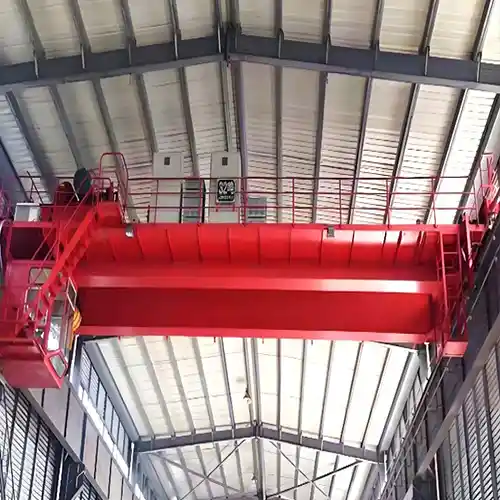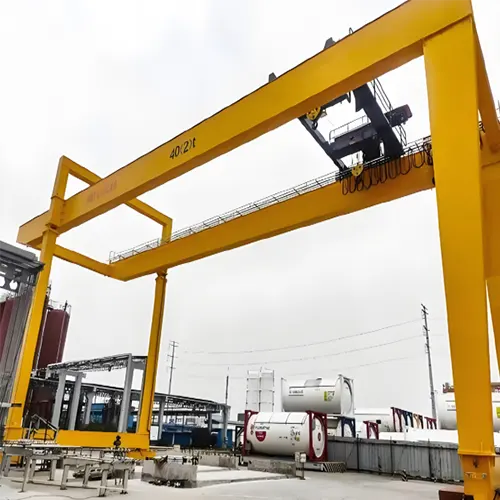Overhead Crane & Gantry Crane for Concrete Pipe Lifting 5 Ton, 10 Ton
Concrete Pipe Handling Cranes for sale. Custom Overhead Cranes & Gantry Crane with Single girder or double girder for 5 to 30 ton precast concrete pipe handling.
Category: Construction
Your Trusted Overhead Cranes and Gantry Cranes Manufacturer & Supplier
Overhead Cranes and Gantry Cranes for Concrete Pipe Handling in Precast Concrete Plants
Concrete Pipe Handling Cranes for sale. Custom Overhead Cranes & Gantry Crane with Single girder or double girder for 5 to 30 ton precast concrete pipe handling.
Concrete pipe production stands as a cornerstone in the construction and infrastructure development, providing the vital conduits for sewer systems, stormwater management, and utility tunnels. In this dynamic industry, the efficiency of material handling plays a pivotal role in ensuring seamless and cost-effective manufacturing processes. At the heart of this efficiency are specialized lifting solutions, with overhead cranes and gantry cranes emerging as key players in the production of seamless concrete pipes.
Efficient material handling is a linchpin in the success of seamless concrete pipe production. As the demand for these essential components continues to grow, manufacturers are compelled to streamline their processes to meet deadlines, reduce costs, and maintain the highest standards of quality. The intricate nature of concrete pipe manufacturing, with its diverse range of diameters and lengths, necessitates precision in material handling to ensure the integrity of the final product. The choice of lifting equipment becomes a critical factor in achieving these objectives.
Among the array of lifting solutions available, overhead cranes and gantry cranes have emerged as indispensable assets in the concrete pipe manufacturing industry. These specialized machines bring a combination of strength, precision, and adaptability to the production floor, addressing the unique challenges posed by handling concrete pipes ranging from 5 to 30 tons. From transporting and rotating to curing pipes, these cranes play a multifaceted role in ensuring a seamless and efficient production process.
Types of Overhead Cranes

Single Girder Overhead Cranes:
Single girder overhead cranes are a versatile and efficient solution for handling concrete pipes in the manufacturing process. With a single bridge girder supporting the hoist, these cranes are well-suited for moderate load capacities. In the context of seamless concrete pipe production ranging from 5 to 30 tons, single girder overhead cranes offer practical advantages.
Applications of Single Girder Overhead Cranes:
Transportation: Efficient movement of concrete pipes within the manufacturing facility.
Rotation: Precise positioning for various manufacturing stages.
Curing: Controlled and safe handling during the curing process.
Advantages of Single Girder Overhead Cranes:
Cost-Effective: Economical solution for moderate load capacities.
Flexible Layout: Suited for facilities with space constraints.
Ease of Maintenance: Simplified maintenance due to fewer components.

Double Girder Overhead Cranes:
Double girder overhead cranes stand out as heavy-duty solutions capable of handling larger and heavier loads with precision. The dual girder design provides increased stability, making them ideal for the substantial weight and dimensions of concrete pipes used in the industry. Their robust construction allows for seamless handling of loads within the specified range.
Applications of Double Girder Overhead Cranes:
Heavy Load Transportation: Lifting and transporting larger and heavier concrete pipes.
Tandem Operation: Collaborative lifting for exceptionally long or heavy pipes.
Versatile Handling: Adaptable to diverse production needs and load specifications.
Advantages of Double Girder Overhead Cranes:
High Load Capacity: Ability to handle substantial loads within the specified range.
Enhanced Stability: Improved stability for precise handling of large and heavy pipes.
Durability: Robust construction for long-term, heavy-duty use.
Gantry Cranes
Gantry cranes play a crucial role in the concrete pipe manufacturing industry, offering mobility and adaptability, especially in outdoor settings and production facilities where the use of traditional overhead crane systems might be challenging. These cranes, with their varied designs, provide an effective solution for lifting, transporting, and positioning concrete pipes during different stages of production.
Types of Gantry Cranes

Single Girder Gantry Cranes:
Single girder gantry cranes are known for their simplicity and efficiency. With a single horizontal beam supporting the hoist, these cranes are well-suited for applications where moderate load capacities and maneuverability are essential. They are commonly employed in scenarios where precise material handling is required, such as the production of concrete pipes.

Double Girder Gantry Cranes:
Double girder gantry cranes, characterized by two horizontal beams, offer enhanced stability and lifting capabilities. These heavy-duty cranes are suitable for handling larger and heavier concrete pipes, making them invaluable in scenarios demanding high load capacities. Their design ensures optimal control and precision during material handling processes.
Application in Outdoor Settings and Production Facilities
- Outdoor Settings: Gantry cranes excel in outdoor environments where the installation of overhead crane systems may not be feasible. Construction sites, storage yards, and areas with irregular terrain benefit from the mobility and flexibility offered by gantry cranes. They provide a reliable solution for lifting and moving concrete pipes outdoors, contributing to seamless construction processes.
- Production Facilities: Within production facilities, gantry cranes are strategically placed to facilitate the movement of materials and products. Their adaptability allows manufacturers to optimize the layout of their facilities, ensuring efficient workflow and minimizing downtime. Gantry cranes provide a versatile solution for handling concrete pipes at various stages of production.
Advantages in Versatile Material Handling
- Maneuverability: Gantry cranes offer exceptional maneuverability, allowing for precise positioning of concrete pipes. This is particularly advantageous in production settings where spatial constraints may require careful navigation.
- Flexibility: The design of gantry cranes allows for versatile material handling. They can be equipped with different hoists and accessories to accommodate various pipe sizes and weights, enhancing their adaptability to changing production requirements.
- Accessibility: Gantry cranes provide accessibility to outdoor areas or locations within a facility where fixed crane systems may have limitations. This accessibility ensures that material handling operations can be efficiently carried out across the entire production site.
In the following sections, we will explore how these gantry cranes, along with overhead cranes, contribute to the handling of concrete pipes in different applications across various industrial sectors. We will also delve into the specific benefits they bring to the seamless production of concrete pipes weighing between 5 to 30 tons.
Specialized Overehad Cranes and Gantry Cranes
The choice between double hoist overhead cranes, variable speed overhead cranes, and tandem operation of overhead cranes depends on specific requirements and the nature of handling long and large concrete pipes. Each option has its advantages, and the decision should consider factors such as load characteristics, production environment, safety considerations, and budget constraints. Here's a brief overview of each option:

Double Hoist Overhead Cranes:
Advantages:
Enhanced load capacity and stability due to the presence of two hoists.
Simultaneous handling of multiple pipes, improving efficiency.
Increased control over the movement and positioning of long and large pipes.
Suitability:
Ideal for scenarios where the weight and length of concrete pipes exceed the capacity of a single hoist crane.
Efficient handling of multiple pipes simultaneously.
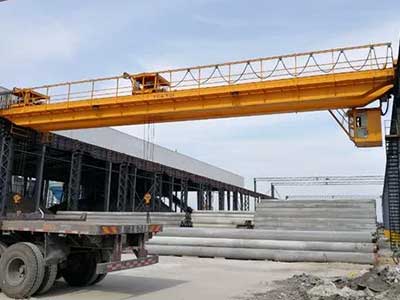
Variable Speed Overhead Cranes:
Advantages:
Precise and controlled movements, allowing for careful handling of long and large concrete pipes.
Adjustable speed settings to accommodate different production stages.
Enhanced safety through smooth acceleration and deceleration.
Suitability:
Suitable for applications where precise positioning, slow and controlled movements, or varying speeds are crucial.
Appropriate when the production process requires different handling speeds.
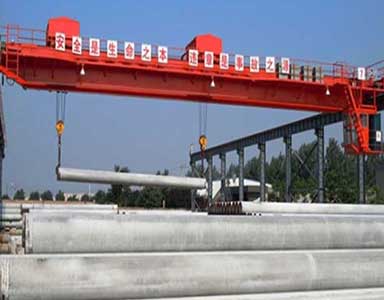
Tandem Operation of Overhead Cranes:
Advantages:
Combines the lifting capacity of two cranes for handling exceptionally heavy or long loads.
Improved stability and control during tandem lifts.
Flexibility in adjusting crane positions for optimal load distribution.
Suitability:
Effective when the weight and length of concrete pipes exceed the capacity of a single crane.
Useful for situations where a collaborative effort between two cranes is necessary.
Considerations for Decision-Making:
Load Characteristics: Consider the weight, length, and other dimensions of the concrete pipes.
Production Environment: Assess the layout and constraints of the production facility.
Safety Requirements: Prioritize safety features and regulations.
Budget Constraints: Evaluate the cost implications of each option.
Ultimately, a detailed analysis of the specific production requirements and constraints will help determine whether double hoist cranes, variable speed cranes, tandem operation, or a combination of these options is the most suitable solution for efficient and safe handling of long and large concrete pipes. Consulting with crane experts or engineers may provide valuable insights tailored to the unique needs of the production process.
Typical Loads in Seamless Concrete Pipe Production
Concrete Pipes of Various Diameters
- Consideration for Small to Large Diameter Pipes: Concrete pipes used in seamless production come in a spectrum of diameters, ranging from the relatively small to the substantially large. This diversity in sizes is dictated by the specific requirements of different applications, such as sewer systems, culvert construction, and utility tunnels. Handling concrete pipes of varying diameters requires a thoughtful approach to ensure that the chosen lifting solutions can accommodate the full spectrum of sizes.
- Adapting Crane Solutions for Diverse Production Needs: The efficiency of seamless concrete pipe production hinges on the adaptability of the crane solutions employed. For smaller diameter pipes, precision and agility are key factors, demanding crane systems capable of navigating confined spaces within manufacturing facilities. Conversely, larger diameter pipes necessitate lifting solutions with increased load capacity and stability. Single girder overhead cranes prove efficient for smaller diameters, while double girder cranes and gantry cranes shine when dealing with the substantial weight and dimensions of larger pipes.
Varying Lengths of Concrete Pipes
Handling Short and Long Pipes Efficiently: In the realm of concrete pipe manufacturing, lengths can vary significantly to meet the specifications of different projects. Efficient handling of both short and long pipes is paramount to maintaining a seamless production flow. Short pipes may require precision in movement, especially during rotation and curing processes, while long pipes demand stability and controlled lifting to prevent deflection and ensure safe transportation.
Crane Features Supporting Different Lengths: Crane features play a pivotal role in accommodating the diverse lengths of concrete pipes. Adjustable lifting attachments and specialized hoist configurations enable precise control over short pipes, ensuring careful handling during critical production stages. For longer pipes, the design and engineering of the cranes come into play, with features like tandem operation for dual crane lifts or extended lifting heights to safely maneuver and transport lengthy components.
As we explore the applications of overhead cranes and gantry cranes in various industrial sectors and delve into their benefits in the seamless production of concrete pipes, the adaptability of these lifting solutions to the varied diameters and lengths becomes a central theme. The synergy between crane capabilities and the characteristics of concrete pipes ensures not only efficient material handling but also the preservation of product integrity throughout the manufacturing process.
Crane Applications in Concrete Pipe Production
Transporting Concrete Pipes
- Efficient Movement Within Manufacturing Facilities: Efficient transportation of concrete pipes within manufacturing facilities is a fundamental application of overhead cranes and gantry cranes. These cranes provide a reliable means to lift and move pipes from one stage of the production process to another. Single girder overhead cranes, with their agility and maneuverability, excel in navigating through the often confined spaces of production facilities. Gantry cranes, whether single or double girder, offer outdoor mobility and versatility in handling pipes in open spaces.
- Minimizing Production Delays: The timely movement of concrete pipes is critical to minimizing production delays and ensuring a smooth workflow. Overhead cranes, with their precise controls, enable operators to transport pipes swiftly and position them accurately at various workstations. Gantry cranes, operating both indoors and outdoors, contribute to a seamless production flow, preventing bottlenecks and optimizing manufacturing timelines.
Rotating Concrete Pipes
- Ensuring Even Curing and Coating: Rotating concrete pipes during the curing and coating processes is essential for achieving uniformity in the final product. Overhead cranes, equipped with specialized lifting attachments or rotating hooks, facilitate controlled and even rotation of the pipes. This ensures that coatings are applied uniformly, and curing takes place consistently across all surfaces. The ability to rotate pipes during these stages enhances the quality and durability of the finished product.
- Facilitating Quality Control Measures: The rotation of concrete pipes is not only about applying coatings but also a crucial aspect of quality control. By rotating pipes during the manufacturing process, operators can inspect and assess the entire surface for defects, ensuring that the pipes meet the required standards. Overhead cranes provide the necessary precision for controlled rotations, allowing for thorough quality checks and the identification of any imperfections.
Curing Concrete Pipes
- Controlled and Safe Curing Processes: Overhead cranes play a pivotal role in the controlled curing of concrete pipes. They are instrumental in lifting and placing pipes in designated curing areas where environmental conditions can be carefully regulated. This controlled environment is crucial for the curing process, ensuring that the concrete sets properly and attains the required strength. Single girder cranes, with their versatility, are often used for precise placement during curing.
- Maintaining the Integrity of the Final Product: The curing stage is a critical phase in concrete pipe production, and the proper handling of pipes during this period is paramount. Overhead cranes provide the means to position pipes securely, preventing any disturbances that could compromise the integrity of the curing process. The controlled lifting and placement of pipes contribute to the overall quality and durability of the final product.
In the subsequent sections, we will explore how overhead cranes and gantry cranes are applied in various industrial sectors for concrete pipe handling. The versatility of these cranes in executing transportation, rotation, and curing processes underscores their indispensable role in ensuring the efficiency and quality of seamless concrete pipe production.
Overhead Cranes and Gantry Cranes in Various Applications
Construction Industry
Lifting and Placing Large Pipes on Construction Sites: In the construction industry, the demand for large-diameter concrete pipes is pervasive, especially in projects involving the development of utility tunnels, culverts, and other essential infrastructure components. Overhead cranes and gantry cranes play a vital role in lifting and placing these sizable pipes onto construction sites with precision and efficiency. The versatility of these cranes allows for seamless integration into diverse construction environments.
Enhancing Productivity in Infrastructure Projects: The utilization of overhead cranes and gantry cranes significantly enhances productivity in infrastructure projects. By efficiently handling and placing large concrete pipes, these cranes contribute to streamlined construction workflows. Their ability to navigate tight construction spaces, coupled with the capacity to lift heavy loads, makes them indispensable assets in the construction industry, ensuring the timely completion of projects.
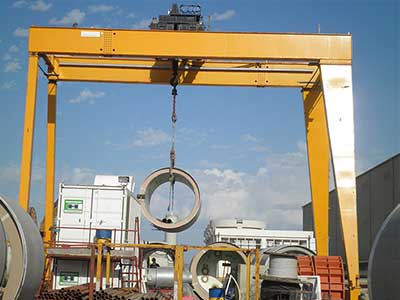
Construction Industry
Concrete Pipe Types:
Function: Used for infrastructure projects, utility tunnels, and culvert construction.
Types and Sizes: Varying diameters (e.g., 12 inches to 120 inches) and lengths based on project requirements.
Crane Type: Overhead Crane
General Crane Design: Single or double girder design for heavy-duty lifting.
Typical Features:
High load capacity suitable for large and heavy concrete pipes.
Precise controls for accurate placement on construction sites.
Adaptability to different pipe sizes and project specifications.
Typical Installation: Overhead cranes are installed within construction sites or manufacturing facilities.
Main Crane Functions and Applications:
Lifting and placing large concrete pipes on construction sites.
Streamlining manufacturing processes for various pipe sizes.
Enhancing productivity in infrastructure projects.
Sewer System Development
Efficient Handling in the Installation of Sewer Systems: Sewer system development involves the installation of concrete pipes of varying sizes and lengths. Overhead cranes and gantry cranes provide efficient solutions for handling these pipes during installation. Single girder cranes excel in navigating confined spaces within sewer systems, while double girder cranes and gantry cranes prove beneficial for lifting and placing larger pipes, contributing to the seamless establishment of comprehensive sewer networks.
Adapting Crane Solutions to Varied Project Requirements: The dynamic nature of sewer system projects often requires adaptable crane solutions. Overhead cranes, with their flexibility in maneuvering through construction sites, accommodate the diverse requirements of different installation scenarios. Gantry cranes, particularly those equipped with adjustable features, offer the versatility needed to adapt to varied project specifications, ensuring efficient material handling during sewer system development.

Sewer System Development
Concrete Pipe Types:
Function: Used in the installation of sewer systems for wastewater transportation.
Types and Sizes: Various diameters (e.g., 15 inches to 72 inches) and lengths to suit sewer system requirements.
Crane Type: Overhead Crane
General Crane Design: Single or double girder design for versatility.
Typical Features:
Efficient handling of varying pipe sizes.
Precision for navigating confined spaces in sewer systems.
Adaptability to different sewer system project specifications.
Typical Installation: Overhead cranes are commonly installed in manufacturing facilities and construction sites.
Main Crane Functions and Applications:
Efficient handling during the installation of sewer systems.
Adapting crane solutions to varied sewer system project requirements.
Stormwater Management
Gantry Cranes for Outdoor Installations in Stormwater Projects: Stormwater management projects often involve outdoor installations of drainage systems, culverts, and stormwater pipes. Gantry cranes, designed for outdoor use, provide a practical solution for lifting and placing concrete pipes in open spaces. Their mobility and stability make them ideal for navigating construction sites where the installation of fixed crane infrastructure may be impractical.
Overhead Cranes in Manufacturing Pipes for Drainage Systems: Within manufacturing facilities dedicated to stormwater management components, overhead cranes become instrumental in the production of concrete pipes for drainage systems. These cranes handle tasks such as transporting, rotating, and curing pipes, ensuring the seamless manufacturing of components that meet the specific requirements of stormwater projects. Their role is essential in maintaining the quality and consistency of the produced pipes.

Stormwater Management
Concrete Pipe Types:
Function: Used for drainage systems in stormwater management to control runoff.
Types and Sizes: Diverse diameters (e.g., 18 inches to 96 inches) and lengths based on stormwater project specifications.
Crane Type: Gantry Crane
General Crane Design: Single or double girder with outdoor mobility.
Typical Features:
Suitable for outdoor installations in stormwater projects.
Lifting capabilities adapted to the weight of pipes and installation requirements.
Versatility in handling pipes in open spaces.
Typical Installation: Gantry cranes are installed in outdoor environments where stormwater projects take place.
Main Crane Functions and Applications:
Gantry cranes used for outdoor installations in stormwater projects.
Overhead cranes involved in manufacturing pipes for drainage systems.
As we explore the diverse applications of overhead cranes and gantry cranes in the construction industry, sewer system development, and stormwater management, it becomes evident that these lifting solutions are not only crucial for efficient material handling but also play a foundational role in the successful execution of essential infrastructure projects. In the subsequent sections, we will delve into the benefits these cranes bring to the production process of seamless concrete pipes, emphasizing their impact on efficiency and quality across different industrial sectors.
Benefits of Using Overhead Cranes and Gantry Cranes
Increased Productivity
- Streamlining Manufacturing Processes: Overhead cranes and gantry cranes contribute significantly to streamlining the manufacturing processes of seamless concrete pipes. Their ability to efficiently handle tasks such as transportation, rotation, and curing ensures a continuous and optimized workflow. By automating material handling, these cranes eliminate bottlenecks, reducing downtime and improving the overall efficiency of the production line.
- Reducing Manual Labor and Production Time: The integration of overhead cranes and gantry cranes results in a substantial reduction in manual labor requirements. The lifting and movement of heavy concrete pipes, which would be labor-intensive without cranes, are streamlined and expedited. This reduction in manual effort not only accelerates production time but also minimizes the physical strain on workers, contributing to a safer and more comfortable working environment.
Enhanced Safety Measures
- Minimizing the Risk of Accidents During Handling: Overhead cranes and gantry cranes are equipped with advanced safety features that minimize the risk of accidents during the handling of concrete pipes. Precision controls, anti-sway systems, and safety interlocks ensure smooth and controlled movements, preventing sudden shifts or swings that could pose dangers to both the load and personnel. This meticulous control mitigates the risk of accidents, safeguarding the integrity of the production process.
- Ensuring a Secure Working Environment for Operators: The safety of crane operators is paramount, and overhead cranes and gantry cranes are designed with operator well-being in mind. Enclosed cabs or remote control operation options provide a secure working environment, protecting operators from potential hazards associated with lifting heavy loads. Ergonomic designs further contribute to operator comfort and safety, ensuring that the workforce operates in a secure and controlled setting.
Versatility in Handling Different Loads
- Adapting to Various Diameters and Lengths: The versatility of overhead cranes and gantry cranes is evident in their capability to adapt to various diameters and lengths of concrete pipes. These cranes can be equipped with adjustable lifting attachments, hooks, or specialized hoists to handle pipes of different sizes. This adaptability ensures that the same crane system can effectively manage the entire spectrum of concrete pipes used in production.
- Enhancing the Flexibility of the Production Line: The flexibility offered by overhead cranes and gantry cranes is a key advantage in the dynamic field of concrete pipe manufacturing. The ability to handle different loads and adjust to varying production requirements enhances the overall flexibility of the production line. This adaptability allows manufacturers to respond swiftly to changes in demand, production schedules, and product specifications.
In conclusion, the utilization of overhead cranes and gantry cranes in seamless concrete pipe production brings a multitude of benefits, ranging from increased productivity and enhanced safety measures to the versatility required to handle a diverse range of loads. These cranes serve as integral components in the manufacturing process, contributing to the overall efficiency, safety, and quality of concrete pipe production across various industrial sectors.
Conclusion
In the seamless concrete pipe production, overhead cranes and gantry cranes stand as indispensable assets, providing pivotal support in various stages of the manufacturing process. From the transportation and rotation of concrete pipes to their controlled curing, these cranes contribute to the efficiency, safety, and quality of the final product.
Overhead cranes, whether single or double girder, and gantry cranes, with their outdoor mobility, play a crucial role in streamlining material handling operations. Their ability to handle loads ranging from 5 to 30 tons makes them versatile solutions for the dynamic requirements of the concrete pipe industry. The importance of these cranes extends beyond the production floor, impacting diverse industrial sectors involved in construction, sewer system development, and stormwater management.
Benefits and Adaptability of Different Crane Types for Varying Loads Across Different Applications
The benefits of utilizing overhead cranes and gantry cranes in concrete pipe production are multifaceted and extend beyond mere material handling. The increased productivity achieved through streamlined manufacturing processes and the reduction of manual labor not only enhance operational efficiency but also contribute to the overall competitiveness of manufacturers in the industry.
The emphasis on enhanced safety measures, with features designed to minimize the risk of accidents during handling, underscores the commitment to creating a secure working environment for operators. The ergonomic designs and safety protocols incorporated into these crane systems prioritize the well-being of the workforce, aligning with modern standards for workplace safety.
Furthermore, the versatility displayed by overhead cranes and gantry cranes in handling various diameters and lengths of concrete pipes enhances the adaptability of the production line. This adaptability ensures that manufacturers can respond effectively to diverse project requirements, changing market demands, and fluctuations in product specifications.
As industries evolve, the adaptability and efficiency brought about by these crane systems continue to play a pivotal role in shaping the landscape of seamless concrete pipe production. The symbiotic relationship between technology, specifically in the form of advanced crane systems, and industrial progress remains a testament to the innovation and commitment driving the construction and infrastructure sectors forward.
In conclusion, the integration of overhead cranes and gantry cranes in concrete pipe production transcends the mere act of lifting and moving loads. It represents a commitment to excellence, safety, and adaptability, with a profound impact on the efficiency and quality of the final product. As these crane systems continue to evolve, their role in shaping the future of concrete pipe manufacturing remains integral to the ongoing advancement of the construction industry.
Main Projects
Related Products

Supplied three grab bucket crane kits to Indonesia, enhancing garbage handling efficiency with high load capacity and reliable performance.
Free consultation to Confirm Parameters & Specifications and Get
Latest Crane Price & Crane Rate.
- Types of overhead cranes : _______?
- Optional: Overhead travelling crane, goliath gantry crane,Slewing jib crane, Single girder or double girder crane,small portable crane or kbk crane, etc.
- Capacity of overhead crane: _______?
- Optional: 0.25ton, 0.5 ton, 1 ton, 2 ton, 3ton, 5 ton, 10 ton,15ton, 20ton, 25 ton, 30ton,35ton, up to 550ton, etc.
- Crane span & lifting height : _______?
- Crane travelling length : _____?
- Control of overhead crane:_______?
- Optional: pendant/ remote/cabin control
- Voltage supply of overhead crane:_____?
- Eg,: 380V50/60HZ,3Phase or others,etc.
- Application/usage of crane:_______?
- Eg,: Steel mill, ,injection mold, cement,stone, concrete,granite, general manufacturing, etc.
Just leave a message via the contact form and our hoist and crane engineer will contact you with in 24working hours.
Get In Touch
